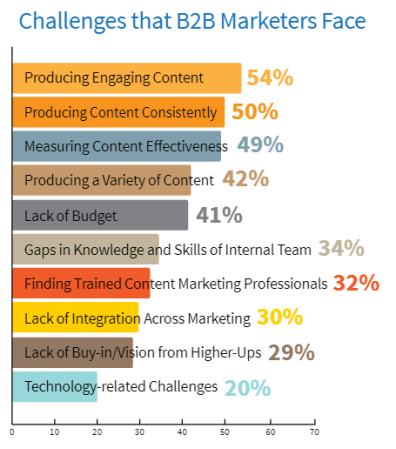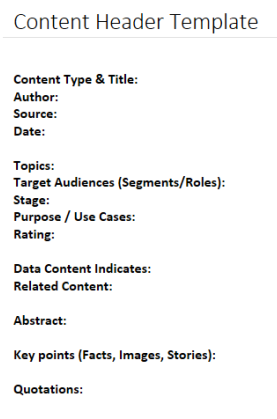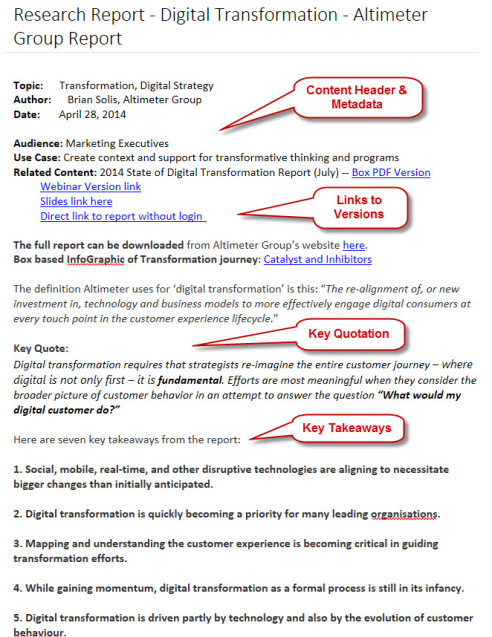Enterprise marketing leaders and chief content officers use many tactics to serve numerous content constituents and their use case requirements. The emergence of the digital enterprise elevates requirements as groups beyond marketing, including sales and channel sales partners, but also customer service and HR (talent acquisition), must be supported in their use of content and content marketing tactics.
One tactic marketers have embraced is content curation. To improve content quality, operational efficiency and return-on-content (all comprising ROI) we think organizations must go beyond current curation practices, to “harvest” the content they curate.
Verb: Curate — “To pull together, sift through, and select for presentation, as music or website content.” “We curate our merchandise with a sharp eye for trending fashion,” the store manager explained. Museums employ curators to select, organize and present art pieces.
Verb: Harvest — “To reap; to gain, win, acquire or use; return or proceeds.” Fishermen harvested hundreds of salmon from the river.
The business problems curation addresses
Content curation today is a severely underutilized tactic, but it offers great potential to address many content challenges marketers face:
- Raising content quality and situational relevance
- Delivering a constant stream of content to address rapidly expanding requirements
- Lowering content creation costs (i.e., time, effort and dollars)
Respondents in a Content Marketing Institute study on B2B marketing trends ranked the top challenges for B2B marketers.

© 2014. Content Marketing Institute. All Rights Reserved. Used with permission.
Most curation practices today are defined by software vendors, based on the functionality of their products. They automate a process that reduces workload and supports primary marketing objectives, especially lead generation and nurturing. The resulting application resembles a newsletter of curated articles.
Some organizations use curation of third-party articles to listen to and monitor industry trends and competitors.
These are good, “level one” starting points. But they’re based on limited thinking: “I need fresh content to send to my list. Curating existing articles from the Web is a good service for my time-constrained audiences. It can be accomplished with low effort and good automation support.”
Companies can use content curation to address significant and costly content-related business objectives. They must start by asking: “To get more out of our content and content investments, how do we:
- Optimize the use of existing content
- Improve the quality and insights of our new, proprietary content
- Lower the time, effort and cost to create a constant stream of new content
- Address the challenge of scaling content operations to “cover” ALL our primary use case requirements such as tailoring for relevance based on audience/persona, buying stage, industry vertical, format preferences and other factors
- Make it easier for content constituents throughout our content, communication and collaboration “ecosystem” to edit content, configure and package new content for specific situations?”
Understanding the causes of curation challenges
By approaching curation from the perspective of how to address these problems raises new questions and creates new thinking.
- Why don’t we optimize the use of existing content? Common responses include: “it’s too hard to find what we need.” “Content is stored in many places.” “When I find content files, it takes too much time and effort to figure out if they meet my needs.”
- What constrains the quality of our insights and content? Comments include: “The experts who have or develop insightful ideas don’t have easy ways to document and share those insights. With third-party sources such as customers, partners, or industry experts, this is an even greater challenge.”
- What are the key causes of the time, effort and cost of creating new content and why is it so hard to scale content production? Answers point out: “Every content project is a fresh start requiring acquisition of critical inputs, and some level of research. Beyond insights, we need access to experts who understand how to apply insights, with the right language, for the relevance factors such as audience/buyer and situational context that content must address. We need supporting facts and data (ideally research based), stories, as well as graphics and images. Also, the approval process for language and brand accuracy is a real constraint.”
- What constrains the ability for people in marketing, sales and the channel to tailor or create new, relevant content for their specific communication situations? Comments: “We aren’t the domain, message or content experts. But we know our audiences and the business and communication objectives of our audiences. The source content we need might be inside existing documents, but it’s not easily found or extracted for our purposes.”
Rethinking curation practices to harvest content
When we answered the above questions for our organizations, we identified new content curation possibilities and opportunities.
Today we curate our internal, proprietary content, as well as third-party content. We employ the “level one” listening and newsletter tactics. But we think about and apply curation in a much broader context.
We recommend four primary activities as better practices, which we refer to as “harvesting” content.
1. Constant acquisition
Our mantra is “acquire constantly.” We curate all new content that we create into a master content inventory. This provides a single point of access to all our content regardless of where it is stored.
We have internal documents of course. But we also have content on our websites, blogs and marketing automation system. More content is stored externally on sites like LinkedIn and Slideshare. Our videos are hosted externally. In all, we have identified 18 repositories of content. Most are appropriate. Some, like Outlook, personal and shared drives, are black holes where content disappears.
Our curation activities extend to email versions and inventories of important stories and message phrasing. The idea is to capture and make easily reusable, common, core elements.
We create and deploy inventory versions for different content constituents including sales, sales channel partners, and others. We curate by identifying and even prioritizing and sequencing the best content for common use case requirements for each group.
An important acquisition practice is to record subject experts, either by direct interviews or in the natural course of their public presentations. (See the “harvest” section below for how this is then handled.)
When we acquire third-party content we go beyond documents to look for other formats such as audio/video, images and graphics.
Key to acquisition is knowing what to acquire and curate. We do this based upon our thorough and documented Enterprise Content Strategy. In this work we define primary topic areas where we can add differentiated value to the public discourse through our content.
We developed organizing and tagging taxonomies from a high-level topic architecture through an organizing schema to a detailed keywords and phrases vocabulary.
Our content inventory, along with our documented use case requirements, make it possible for us to continually identify content gaps, new or emerging topic areas and priorities for new content — both curated and proprietary.
2. Prepare content using a content header
To improve search and discovery of content for specific situations, we apply a content header to all content. Most importantly, it provides a fast way to skim and review search returns to quickly identify appropriate content.

3. Harvest the contentS of the content
The harvest step is perhaps the most significant part of our curation practice.
When curating both internally developed and third-party content, we harvest specific elements from within the source content itself:
- Plain text from the content, or transcribed from audio and video recordings
- Research results, facts, data, images and graphics
- Quotations, stories, examples and key insights
- Links to multiple versions or formats of the content, as well as related content
- Social media versions suitable, for example, for Twitter, LinkedIn or Google+ posts
It requires only a little marginal time and effort to extract, edit, modularize and tag content for access and re-use.
A more mature practice involves creating new content elements from this source content. Examples include the creation of version of pre-determined content, such as emails and social media messages with links to content. This reduces or eliminates creation by downstream users of content that lack the time, knowledge or desire to prepare this content for delivery.

© 2014 Altimeter Group. All Rights Reserved. Used with permission.
4. Manage and deploy plain text repository as “content source”
Digital content and communication channels have brought an explosion in content repositories that most organizations haven’t yet addressed well. In addition to document and other source repositories, a digital asset management system, or DAMS, is an essential curation repository to store images, graphic, audio and video files.
One of our most important tools is our plain text repository, which we call “Content Source.”
In Content Source we manage text elements of all customer-facing content so the “contentS” and language are easily accessible for re-use in whole or in part. This is also a good way to manage links to different versions or related content.
Here is an 80-second video showing how this works, with an example of an internal content asset.
Take-aways
- Continuously curate internal and third party content and harvest insights, language, stories and other source input to support new content creation by ALL your communication constituents.
- Build out your Content Source repository and you will improve the quality of your content.
- Use a content header to increase content value by making it easy to find and reuse.
This is a manageable way to scale your content operations and lower your marginal cost of content even as you scale.
Content curation and harvesting, as continuous acquisition, editing and preparation into Content Source, has become a mindset and regular practice for us and our clients. From this, new opportunities and techniques emerge.
You and your content constituents will wonder why you didn’t start this practice years ago.
Jim Burns is president of Avitage, a 20-year content operations management company in Boston, Massachusetts. Avitage helps enterprise sales and marketing organizations get more out of content investments — quality, outputs and business outcomes. Avitage deploys a structured content publishing operation that addresses the operational challenges of creating a constant stream of audience-relevant content for multiple purposes in many versions and formats, at scale, without dramatically escalating resources and costs. Follow him at http://www.linkedin.com/in/jimburnsavitage.
Mark Gibson is CEO and founder of Advanced Marketing Concepts (Admarco), a B2B marketing messaging agency founded in the UK in 2004 and now based in the Bay Area of San Francisco. Admarco helps sales and marketing organizations develop better content, better content process and improve content ROI. Engagements include content strategy and frameworks to create content that resonates with buyers to drive inbound leads, and conversation support tools to connect with buyers. Contact him at mark.gibson@admarco.net.
